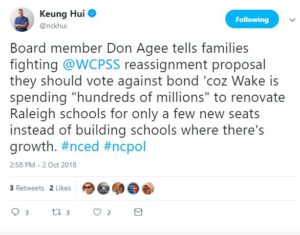Are We Funding Our Schools Adequately?
Amid gasps of outrage from the conservative blogosphere, the Wake County Board of Education (BoE) submitted their annual budget request to the Wake County Commission during the first week of May, 2018.
Each year when the official request is submitted, letters from the BoE and district Superintendent that accompany the full report inform the commissioners about the school system’s plans to improve the quality of district schools and provide some context for the present budget request. Monica Johnson-Hostler, Chair of the Wake BoE, wrote a more succinct letter this year than in 2017. She does not mince words when it comes to recent funding shortfalls: “state support, which provides the majority of funding for the school system, has lagged behind local efforts.” She adds that “public education in Wake County is still struggling to overcome the challenges that began during the Great Recession.”
It should come as no surprise that the district and the Wake BoE ask for increased funding from the county every year–yet somehow, it always does seem to surprise people. The county’s population has been rapidly growing since 1980; the population more than doubled between 1980 and 2000 (to 627,846). It’s unlikely to double again by 2020, but in Dec. 2017, census projections estimated that the population stood at 1,072,203.
In 2018, the BoE asked for a much larger “raise” than the Board of Commissioners had expected: $58.9 million more than last year. The Raleigh News & Observer attributes the increase to the following factors:
- Enrollment growth and the opening of four new schools
- (Unfunded) state mandates, such as the K – 3 class-size reductions–estimated to cost the county $19.5 million for the coming year
- The higher cost of retiree health benefits
- Additional school guidance counselors and social workers
Multiple experts have agreed that counselors and social workers are a priority to attempt to reduce the threat of school violence; Wake’s schools currently exceed the recommended ratio of students to counselors by 200 students per counselor. However, a plan to add such mental-health staff had to be cut from the 2017-18 budget when the BoC didn’t provide the full amount of the requested budget. It’s likely to be cut again, now that the BoC has voted to provide $13.9 million less than this year’s request.
The request for an enormous increase in the WCPSS budget isn’t unprecedented. The previous board’s request for the 2015-16 school year resulted in $44.6 million in additional funding from the county. (Last year, however, the present board only ended up getting a $23.9 million increase, even though they requested an increase of $35.7 million. The BoC has been drawing the purse-strings tighter of late.)
Wake County residents who are fatigued with constant county tax increases (levied five years in a row) complain that the school system wastes money on “administrative bloat,” new school construction, and unnecessary programs (for example, A.P. Dillon of the LadyLiberty1885 blog cites “the various layers of social justice bullcrap that have been inserted into WCPSS”). Uniquely, current BoE member Donald Agee has argued that renovations of existing schools are wasteful; by contrast, Dillon takes the more common tack, complaining that while the district spends profligately on new schools and whacky ideas, “our youngest and most vulnerable students are sitting ducks in run-down, old trailer farms behind nearly every single school in the district.”

Dillon and the Civitas Institute also criticize WCPSS for overestimating enrollment growth. The average number of students in all grades who attended a school in the WCPSS district (the ADM, or average daily membership) for 2017-18 was 158,970, as reported by NCDPI. The WCPSS website cites a higher figure: the ADM from the second month of the school year, which was the peak enrollment for the year: 160,429. They probably selected the higher figure because the largest number matters the most to the school system; they must, after all, provide a slot for every student who attempts to enroll.
Writing for the Civitas blog, Bob Luebke includes a table showing that WCPSS’s own estimate, which they made in 2013, expected enrollment in district schools to be substantially higher in 2017-18: 167,297.
But in 2013, when the higher projections were published, the statewide cap of 100 charter schools was still in place, and birth rates were also projected to trend higher. A Dec. 2017 article from the Charlotte Observer reports that enrollment growth in NC public schools has been slowing. The lower-than-expected enrollment has been especially noticeable in newer public elementary schools in some Charlotte-area suburbs, presumably because the children who were born during the Great Recession are now of elementary age—and the recession had a sharply negative effect on birth rates. But the other factors at play include an upward trend in families that choose to home-school or to enroll their child in a charter school or a private school; a longer-term negative trend in the birth rate; reduced immigration; and less mobility: as people stay in their homes longer, their children eventually age out of the school system and are not replaced by younger children.
Has WCPSS been remiss in building so many new schools on the taxpayers’ dime? Critics seem to want it both ways: they want WCPSS to comply with the unreasonable state-mandated reductions in K – 3 class sizes without building new schools, despite the continued enrollment growth in the system. They’re outraged that students must often learn in modular classrooms, but they complain about the cost of building new schools, even as the district sees huge increases in construction costs. Critics also want the schools to be safer, but they don’t want to pay higher taxes to fund additional counselors or security features, such as surveillance equipment and redesigned, centralized entrances that can be more easily guarded. And no year-round schools for our little darlings…even though year-round schools save loads of money! There must be some fat somewhere in the WCPSS budget that can be cut so that balance can be achieved without raising student fees, or without converting schools to a year-round calendar.
Critics of WCPSS’s spending habits also ignore the fact that nearby Orange County, home of the excellent Chapel Hill-Carrboro Schools, spent $4,852 in local dollars per student in 2015-16; Wake spent only $2,316.
Recent history strongly indicates that WCPSS will be attacked about their large budget no matter what they do. The contrary and wishful notions that Wake parents and citizens nurture about the annual budget request are still less absurd than arguments against the bond issue that will appear as a referendum on the November ballot to fund school construction and renovations. The statements by the anti-bond crowd seem to run something like this: Find some other way to pay for enrollment growth, which y’all are exaggerating, by the way. No bonds. No more tax increases. No new year-round schools. No additional spending on school counselors or social workers. But we do need additional bus routes, safer schools, and less-crowded schools. Oh, and if the quality of the public schools suffers due to a lack of funding, we’ll just move our kids into home schools or charter schools. Yes, eventually, enough people will do that to teach WCPSS a real lesson!
And then we’ll complain about the impact of failing schools on our property values.

